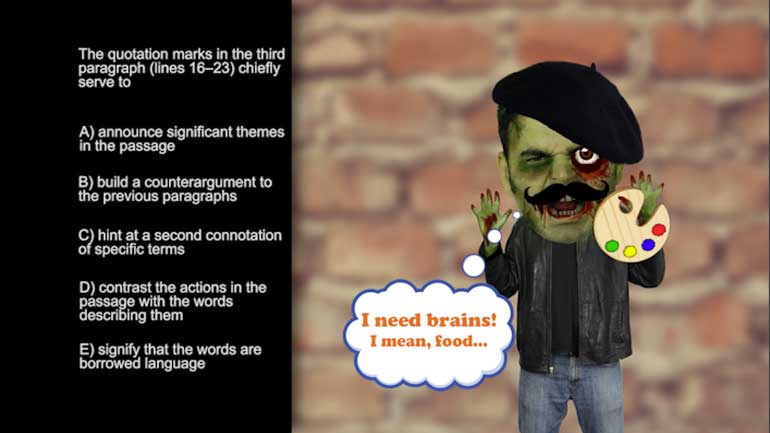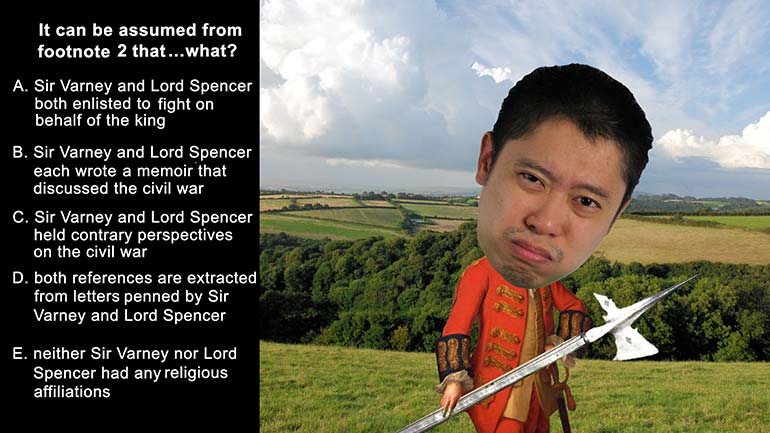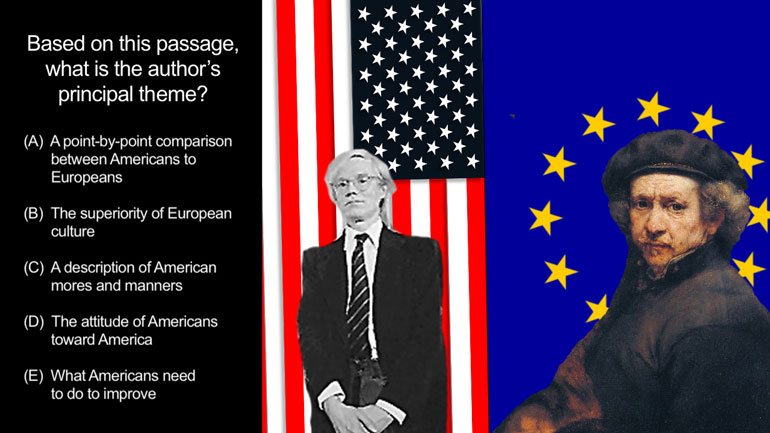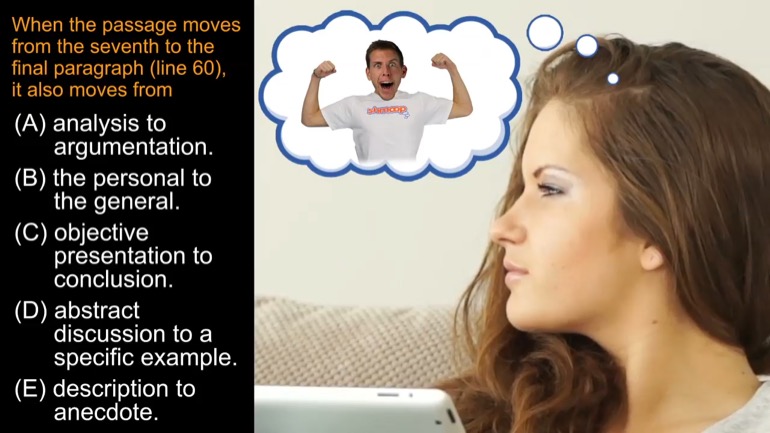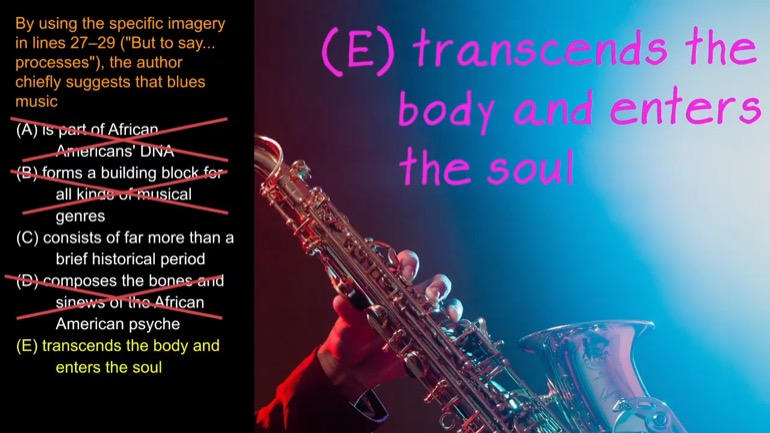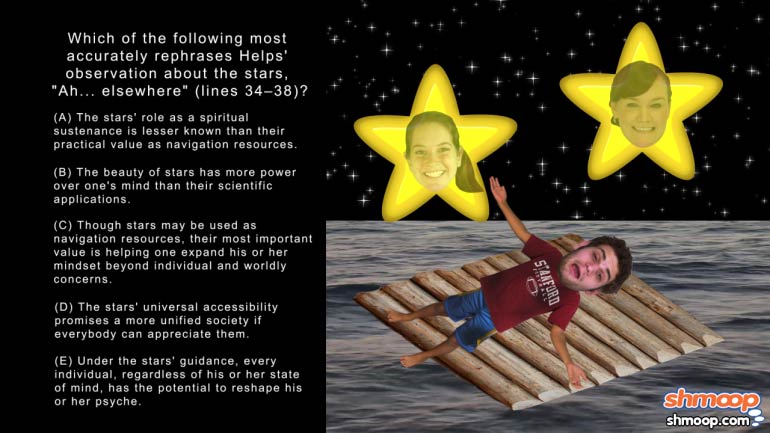ShmoopTube
Where Monty Python meets your 10th grade teacher.
Search Thousands of Shmoop Videos
Passage Drill Videos 141 videos
AP English Language and Composition: Passage Drill Drill 1, Problem 2. What is the speaker's primary purpose in using onomatopoeia in line four?
AP English Language and Composition: Passage Drill Drill 1, Problem 7. What is the principal rhetorical function of paragraphs one to three?
AP English Language and Composition: Passage Drill 1, Problem 8. The quotation marks in the third paragraph chiefly serve to what?
AP English Language and Composition 7.7 Passage Drill 15 Views
Share It!
Description:
AP English Language and Composition 7.7 Passage Drill. The selected line contains which of the following?
Transcript
- 00:00
and here's your shmoop du jour brought to you by natural
- 00:06
history. not to be confused with au natural history. a controversial
- 00:11
approach to teaching students about our past which presupposes that everyone
- 00:14
living prior to the century was totally naked. yeah lawyers had a field day with [American founding fathers shirtless]
- 00:19
that one. all right check out the following passage which we're just going
Full Transcript
- 00:22
to skim because well on our screen is little tiny print. [skim]
- 00:26
[mumbling]
- 00:35
alright we're done. the line the course of nature as It is, as it has been and as
- 00:42
it will be with the object of scientific inquiry whatever lies beyond the bottle
- 00:49
below this is outside science. contains which of the following. all right
- 00:54
[mumbling]
- 00:59
the focus here is not only what the quote says but also how it is said thank you very much.
- 01:03
this is a staple component of rhetoric called a rhetorical or literary device.
- 01:09
rhetoric is persuasive speech or writing and rhetorical devices are techniques [rhetorical device options]
- 01:14
that make what said interesting and convincing. we probably wouldn't consider
- 01:19
this guy's use of repetition and intriguing rhetorical device. on the
- 01:22
other hand this tortured student makes it sound much more convincing. repetition
- 01:26
may be one of the most common rhetorical devices but it's far from being the only
- 01:29
one .first what's this line saying. well essentially the course of nature is was
- 01:34
and always will be the object of scientific inquiry. fancy way of saying a
- 01:38
scientist purpose is to understand and explain nature .the second part means
- 01:41
that which is not observable and therefore cannot be proven is not
- 01:45
scientific. now let's throw our writer thinking cap on and interpret these
- 01:50
techniques. ever heard someone call something a catch-22 ?it means a
- 01:54
situation is a paradox . well the phrase was coined from a book of the same name
- 01:58
catch-22. great book you should read it. the book said during World War two is [teddy bear wonders about the meaning of catch-22.]
- 02:02
about a fighter pilot who wants out of the war. to get out of that combat duty a
- 02:06
soldier must be mentally evaluated and proven insane and therefore unfit to
- 02:09
fight. but there's a catch. if a pilot is sane he must fly well. if he's crazy than
- 02:15
he doesn't have to. so a pilot has to be crazy to fly because it's they're
- 02:19
dangerous so saying he doesn't want to fly means he's sane. he still has to
- 02:24
fly. it's an unending circle an unsolvable contradiction, a catch-22. now
- 02:29
metonymy is a figure of speech. take Julius Caesar please
- 02:34
the name of a person object or idea is replaced by something associated
- 02:38
to it. clearly this request was for attention not to address an ear shortage
- 02:43
problem. Hyperbole is like literally the most extreme literary device ever. this
- 02:49
exaggeration is intended to emphasize a point. not to be taken like literally.
- 02:54
parallel ism is a device that helps clarify a point by giving balance. what [Hyperbole explained]
- 02:59
you see is what you get. consistency is key to proving a point. otology may sound
- 03:04
similar but it's a more exact repetition kind of like saying repeat that again? ok
- 03:09
so which rhetorical device fits the best? well this description of science may
- 03:14
sound like hyperbole but it's no exaggeration. it's simply fact. the decisive
- 03:18
stands uses straightforward language, no figures of speech metonymy or
- 03:23
paradoxes. deciding between you two can be tough because both involve repetition.
- 03:27
remember tautology says the same thing in different ways. meaning d parallelism
- 03:33
is the better choice. there's some echo here but never anything that reiterates [parallelism defined]
- 03:37
exact words or phrases. as it is as it has been as it will be demonstrates
- 03:43
parallelism on two levels .one there's the repetition of as. two is absent and
- 03:49
will be or present past and future is a persuasive way to emphasize always .the
- 03:56
author uses parallelize and a third time writing beyond above or below to
- 03:59
describe what it's outside of science. the one-two-three punch parallelize
- 04:04
makes for perfect persuasion. sorry we spit on you there. [woman hits a man in the jaw with gloved fist]
Related Videos
AP English Literature and Composition 1.1 Passage Drill 7. The primary purpose of this passage is what?
Take a look at this shmoopy question and see if you can figure out which device the speaker employs the most.
Feel like shifting gears and answering a question about shifting tones? We've got you covered. Take a look at this question and see if you can foll...
AP English Language and Composition: Passage Drill Drill 1, Problem 2. What is the speaker's primary purpose in using onomatopoeia in line four?
Wishing upon a star may help you pass your AP English Language and Composition test, but answering this question would be a safer bet.


